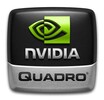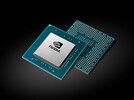NVIDIA Quadro T2000 Max-Q vs NVIDIA Quadro K620M vs NVIDIA Quadro T1000 Max-Q
NVIDIA Quadro T2000 Max-Q
► remove from comparisonThe Nvidia Quadro T2000 with Max-Q Design is a professional mobile graphics card that is based on the Turing architecture (TU117 chip). It is based on the consumer desktop GTX 1650 Ti therefore currently between a mobile GTX 1650 and GTX 1660 Ti. The chip is manufactured in 12nm FinFET at TSMC. Compared to the normal Quadro T2000, the Max-Q variants are clocked lower and work in a more efficient state. Currently, we know of two variants with different clock speeds and power consumptions (35 and 40 W).
| Model | Shader | TGP (W) | Base (MHz) | Boost (MHz) |
| Quadro T2000 Mobile | 1024 | 60 | 1575 | 1785 |
| Quadro T2000 Max-Q | 1024 | 40 | 1200 | 1620 |
| Quadro T2000 Max-Q | 1024 | 35 | 930 | 1500 |
| GeForce GTX 1650 Ti (Desktop) | 1024 | 75? | 1530 | 1725 |
| GeForce GTX 1660 Ti Mobile | 1536 | 80 | 1455 | 1590 |
| GeForce GTX 1650 Mobile | 896 | 50 | 1395 | 1560 |
The Turing generation did not only introduce raytracing for the RTX cards, but also optimized the architecture of the cores and caches. According to Nvidia the CUDA cores offer now a concurrent execution of floating point and integer operations for increased performance in compute-heavy workloads of modern games. Furthermore, the caches were reworked (new unified memory architecture with twice the cache compared to Pascal). This leads to up to 50% more instructions per clock and a 40% more power efficient usage compared to Pascal.
The performance in professional apps should be clearly lower than a normal (Max-P) Quadro T2000 due to the lower clock speeds, but still ahead the slower Quadro T1000 due to the higher shader count. Compared to consumer cards, the mobile GTX 1650 should be still slower.
Thanks to the relative low power consumption of the Quadro T2000 Max-Q, the GPU is suited for thin and light laptops. The used TU116 chip is manufactured in 12nm FFN at TSMC.
NVIDIA Quadro K620M
► remove from comparison
The Nvidia Quadro K620M is a DirectX 11 and OpenGL 4.5-compatible graphics card for mobile workstations. It is a Maxwell-based GPU built on the GM108 chip with 384 shader cores and manufactured in 28 nm by TSMC. The Quadro K620M is the successor to the significantly slower Quadro K610M. Usually, the GPU comes with 2 GB DDR3 memory clocked at 1000 MHz (2000 MHz effective, 16 GB/s).
The Quadro series offers certified drivers that are optimized for stability and performance in professional applications like CAD or DCC. OpenGL performance, for example, should be significantly better than with GeForce graphics cards of similar specifications.
Architecture
Compared to Kepler, Maxwell has been optimized in several details to increase power efficiency. Smaller Streaming Multiprocessors (SMM) with only 128 ALUs (Kepler: 192) and an optimized scheduler should lead to better utilization of the shaders. Nvidia promises that a Maxwell SMM with 128 ALUs can offer 90% of the performance of a Kepler SMX with 192 ALUs. GM108 features 3 SMMs and thus 384 shader cores, 24 TMUs and 8 ROPs (64-bit interface).
Another optimization is the massively enlarged L2 cache. The larger size can reduce some of the memory traffic to allow for a relatively narrow memory interface without significantly hurting performance.
GM108 supports DirectX 11.2 (feature level 11.0 only) as well as DirectX 12.
Performance
Due to their identical specifications, the Quadro K620M offers a similar 3D gaming performance as the consumer GeForce 840M. Most games from 2014/2015 will run fluently in low or medium settings. Compared to other Quadro GPUs, the K620M performs almost similar to the older K1100M.
Features
The feature set should include support for up to 4 active displays. High-resolution monitors of up to 3840x2160 pixels can be connected using DisplayPort 1.2 or HDMI 1.4a (HDMI 2.0 not supported). HD-Audio codecs, such as Dolby TrueHD and DTS-HD, can be transmitted via bitstream mode through the HDMI port. However, as most laptops will feature Optimus, the integrated GPU will likely have direct control over the display ports and may limit the feature set available by the Nvidia Kepler cards.
Using CUDA or OpenCL, the cores of the Quadro K620M can be used for general calculations.
GM108 integrates the sixth generation of the PureVideo HD video engine (VP6), offering a better decoding performance for H.264 and MPEG-2 videos. Of course, VP6 supports all features of previous generations (4K support, PIP, video encoding via NVENC API).
Power Consumption
The power consumption of the Quadro K620M should be about 30 W including the board and memory components. Therefore, the GPU is best suited for laptops 13 - 14-inches in size and above. The K620M also supports Optimus to automatically switch between an integrated graphics card and the Nvidia GPU.
NVIDIA Quadro T1000 Max-Q
► remove from comparison
The Nvidia Quadro T1000 with Max-Q Design is a professional mobile graphics card that is based on the Turing architecture (TU117 chip). Compared to the consumer GTX 1650, the Quadro T1000 features less CUDA cores / shaders (768 versus 896). The chip is manufactured in 12nm FinFET at TSMC. Compared to the normal Quadro T1000, the Max-Q variants are clocked lower and work in a more efficient state. Currently, we know of two variants with different clock speeds and power consumptions (35 and 40 W).
| Model | Shader | TGP (W) | Base (MHz) | Boost (MHz) |
| Quadro T1000 Mobile | 768 | 50 | 1395 | 1455 |
| Quadro T1000 Max-Q | 768 | 40 | 1230 | 1455 |
| Quadro T1000 Max-Q | 768 | 35 | 795 | 1455 |
| Quadro T2000 Mobile | 1024 | 60 | 1575 | 1785 |
| GeForce GTX 1650 Mobile | 896 | 50 | 1395 | 1560 |
The Quadro T1000 is a mobile graphics card that is based on the Turing architecture (TU116 chip). Compared to the faster RTX 2000 GPUs (e.g. RTX 2060), the T1000 integrates no Raytracing or Tensor cores. Due to the same boost clock as the mobile T1000, the Max-Q variants can perform similar with sufficient cooling.
The Turing generation did not only introduce raytracing for the RTX cards, but also optimized the architecture of the cores and caches. According to Nvidia the CUDA cores offer now a concurrent execution of floating point and integer operations for increased performance in compute-heavy workloads of modern games. Furthermore, the caches were reworked (new unified memory architecture with twice the cache compared to Pascal). This leads to up to 50% more instructions per clock and a 40% more power efficient usage compared to Pascal.
Thanks to the low power consumption, the Max-Q T2000 GPU can be used in thin and light laptops. The used TU116 chip is manufactured in 12nm FFN at TSMC.
| NVIDIA Quadro T2000 Max-Q | NVIDIA Quadro K620M | NVIDIA Quadro T1000 Max-Q | |||||||||||||||||||||||||||||||||||||||||||||||||||||||||||||||||||||||||||||||||||||||||||||||||||||||||||||||||||||||||||||||||||||||||||||||||
| Quadro Turing Series |
|
|
| ||||||||||||||||||||||||||||||||||||||||||||||||||||||||||||||||||||||||||||||||||||||||||||||||||||||||||||||||||||||||||||||||||||||||||||||||
| Codename | N19P-Q3 MAX-Q | N19P-Q1 | |||||||||||||||||||||||||||||||||||||||||||||||||||||||||||||||||||||||||||||||||||||||||||||||||||||||||||||||||||||||||||||||||||||||||||||||||
| Architecture | Turing | Maxwell | Turing | ||||||||||||||||||||||||||||||||||||||||||||||||||||||||||||||||||||||||||||||||||||||||||||||||||||||||||||||||||||||||||||||||||||||||||||||||
| Pipelines | 1024 - unified | 384 - unified | 768 - unified | ||||||||||||||||||||||||||||||||||||||||||||||||||||||||||||||||||||||||||||||||||||||||||||||||||||||||||||||||||||||||||||||||||||||||||||||||
| Core Speed | 930 / 1200 - 1500 / 1620 (Boost) MHz | 1029 - 1124 (Boost) MHz | 795 / 1230 - 1455 (Boost) MHz | ||||||||||||||||||||||||||||||||||||||||||||||||||||||||||||||||||||||||||||||||||||||||||||||||||||||||||||||||||||||||||||||||||||||||||||||||
| Memory Speed | 8000 MHz | 2000 MHz | 8000 MHz | ||||||||||||||||||||||||||||||||||||||||||||||||||||||||||||||||||||||||||||||||||||||||||||||||||||||||||||||||||||||||||||||||||||||||||||||||
| Memory Bus Width | 128 Bit | 64 Bit | 128 Bit | ||||||||||||||||||||||||||||||||||||||||||||||||||||||||||||||||||||||||||||||||||||||||||||||||||||||||||||||||||||||||||||||||||||||||||||||||
| Memory Type | GDDR5 | DDR3 | GDDR5 | ||||||||||||||||||||||||||||||||||||||||||||||||||||||||||||||||||||||||||||||||||||||||||||||||||||||||||||||||||||||||||||||||||||||||||||||||
| Max. Amount of Memory | 4 GB | 2048 MB | 4 GB | ||||||||||||||||||||||||||||||||||||||||||||||||||||||||||||||||||||||||||||||||||||||||||||||||||||||||||||||||||||||||||||||||||||||||||||||||
| Shared Memory | no | no | no | ||||||||||||||||||||||||||||||||||||||||||||||||||||||||||||||||||||||||||||||||||||||||||||||||||||||||||||||||||||||||||||||||||||||||||||||||
| API | DirectX 12_1, OpenGL 4.6 | DirectX 11, Shader 5.0, OpenGL 4.3 | DirectX 12_1, OpenGL 4.6 | ||||||||||||||||||||||||||||||||||||||||||||||||||||||||||||||||||||||||||||||||||||||||||||||||||||||||||||||||||||||||||||||||||||||||||||||||
| Power Consumption | 35 - 40 Watt | 30 Watt | 35 - 40 Watt | ||||||||||||||||||||||||||||||||||||||||||||||||||||||||||||||||||||||||||||||||||||||||||||||||||||||||||||||||||||||||||||||||||||||||||||||||
| Transistors | 4.7 Billion | ||||||||||||||||||||||||||||||||||||||||||||||||||||||||||||||||||||||||||||||||||||||||||||||||||||||||||||||||||||||||||||||||||||||||||||||||||
| technology | 12 nm | 28 nm | 12 nm | ||||||||||||||||||||||||||||||||||||||||||||||||||||||||||||||||||||||||||||||||||||||||||||||||||||||||||||||||||||||||||||||||||||||||||||||||
| Notebook Size | medium sized | medium sized | |||||||||||||||||||||||||||||||||||||||||||||||||||||||||||||||||||||||||||||||||||||||||||||||||||||||||||||||||||||||||||||||||||||||||||||||||
| Date of Announcement | 27.05.2019 | 01.03.2015 | 27.05.2019 | ||||||||||||||||||||||||||||||||||||||||||||||||||||||||||||||||||||||||||||||||||||||||||||||||||||||||||||||||||||||||||||||||||||||||||||||||
| Features | Optimus, PhysX, CUDA, OpenCL, 3D Vision, 3DTV Play | ||||||||||||||||||||||||||||||||||||||||||||||||||||||||||||||||||||||||||||||||||||||||||||||||||||||||||||||||||||||||||||||||||||||||||||||||||
| Link to Manufacturer Page | www.nvidia.de |
Benchmarks
3DM Vant. Perf. total + NVIDIA Quadro T2000 Max-Q
specvp11 snx-01 + NVIDIA Quadro K620M
specvp12 sw-03 + NVIDIA Quadro T2000 Max-Q
Cinebench R15 OpenGL 64 Bit + NVIDIA Quadro T2000 Max-Q
GFXBench T-Rex HD Offscreen C24Z16 + NVIDIA Quadro T2000 Max-Q
Average Benchmarks NVIDIA Quadro T2000 Max-Q → 0% n=0
Average Benchmarks NVIDIA Quadro K620M → 0% n=0
* Smaller numbers mean a higher performance
1 This benchmark is not used for the average calculation
Game Benchmarks
The following benchmarks stem from our benchmarks of review laptops. The performance depends on the used graphics memory, clock rate, processor, system settings, drivers, and operating systems. So the results don't have to be representative for all laptops with this GPU. For detailed information on the benchmark results, click on the fps number.

F1 2020
2020
Gears Tactics
2020
Doom Eternal
2020
Hunt Showdown
2020
GRID 2019
2019
Borderlands 3
2019
Control
2019
Anno 1800
2019
Dirt Rally 2.0
2019
Far Cry New Dawn
2019
Metro Exodus
2019
Apex Legends
2019
X-Plane 11.11
2018
Dota 2 Reborn
2015
The Witcher 3
2015
Ryse: Son of Rome
2014
GRID: Autosport
2014
Thief
2014
Total War: Rome II
2013
Saints Row IV
2013
Company of Heroes 2
2013
Metro: Last Light
2013
BioShock Infinite
2013
Tomb Raider
2013
Assassin´s Creed III
2012
Hitman: Absolution
2012
World of Tanks v8
2012
F1 2012
2012
Sleeping Dogs
2012
Dirt Showdown
2012
Diablo III
2012
Alan Wake
2012
Batman: Arkham City
2011
StarCraft 2
2010Average Gaming NVIDIA Quadro T2000 Max-Q → 100%
Average Gaming 30-70 fps → 100%
Average Gaming NVIDIA Quadro K620M → 19%
| NVIDIA Quadro T2000 Max-Q | NVIDIA Quadro K620M | NVIDIA Quadro T1000 Max-Q | |||||||||||||||||||
|---|---|---|---|---|---|---|---|---|---|---|---|---|---|---|---|---|---|---|---|---|---|
| low | med. | high | ultra | QHD | 4K | low | med. | high | ultra | QHD | 4K | low | med. | high | ultra | QHD | 4K | ||||
| F1 2020 | 182 | 96 | 78 | 55 | |||||||||||||||||
| Gears Tactics | 263.3 | 77.5 | 47.6 | 35.1 | |||||||||||||||||
| Doom Eternal | 147.4 | 85.5 | 58.1 | ||||||||||||||||||
| Hunt Showdown | 141.3 | 50.3 | 44.5 | ||||||||||||||||||
| Star Wars Jedi Fallen Order | 64.2 | 53.1 | 47 | ||||||||||||||||||
| GRID 2019 | 179 | 94.7 | 77.7 | 51 | |||||||||||||||||
| Borderlands 3 | 123.4 | 56 | 35.8 | 27.3 | |||||||||||||||||
| Control | 120.2 | 40.4 | 28.3 | ||||||||||||||||||
| Total War: Three Kingdoms | 148.4 | 60.3 | 36.3 | 24.4 | |||||||||||||||||
| Anno 1800 | 27.86 | 12.9 | 9.8 | ||||||||||||||||||
| Dirt Rally 2.0 | 271 | 86.1 | 69.9 | 40.3 | |||||||||||||||||
| Far Cry New Dawn | 83 | 58 | 55 | 50 | |||||||||||||||||
| Metro Exodus | 91.5 | 41.74 | 31.2 | 24.6 | |||||||||||||||||
| Apex Legends | 144 | 86.4 | 72.7 | 64.9 | |||||||||||||||||
| Assassin´s Creed Odyssey | 71 | 53 | 45 | 25 | |||||||||||||||||
| Shadow of the Tomb Raider | 101 | 56 | 48 | 42 | |||||||||||||||||
| X-Plane 11.11 | 96 | 82 | 69 | 47.2 | |||||||||||||||||
| Final Fantasy XV Benchmark | 91 | 45 | 33 | 25.7 | 13 | ||||||||||||||||
| Dota 2 Reborn | 149 | 136 | 124 | 113 | 46 | ||||||||||||||||
| The Witcher 3 | 181 | 107.6 | 62.5 | 33 | |||||||||||||||||
| BioShock Infinite | 79.5 | 73 | 52 | 42 | 15 | ||||||||||||||||
| NVIDIA Quadro T2000 Max-Q | NVIDIA Quadro K620M | NVIDIA Quadro T1000 Max-Q | |||||||||||||||||||
| low | med. | high | ultra | QHD | 4K | low | med. | high | ultra | QHD | 4K | low | med. | high | ultra | QHD | 4K | < 30 fps < 60 fps < 120 fps ≥ 120 fps | 1 6 12 | 1 8 10 1 | 2 11 6 1 | 4 8 3 | 1 | 1 2 | < 30 fps < 60 fps < 120 fps ≥ 120 fps | 1 | 1 | 1 | 1 | | | < 30 fps < 60 fps < 120 fps ≥ 120 fps | | | | | | |
For more games that might be playable and a list of all games and graphics cards visit our Gaming List




















